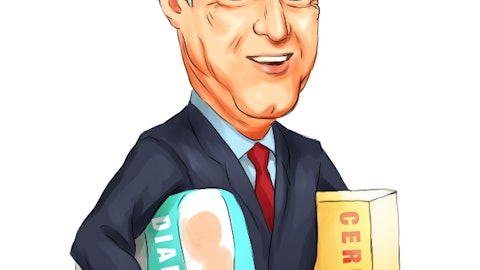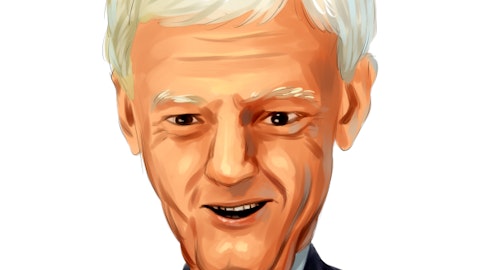State Street Corporation (NYSE:STT) Q4 2022 Earnings Call Transcript January 20, 2023
Operator: Good morning and welcome to State Street Corporation’s Fourth Quarter and Full Year 2022 Earnings Conference Call and Webcast. Today’s discussion is being broadcasted live on State Street’s Web site at investors.statestreet.com. This conference call is also being recorded for replay. State Street’s conference call is copyrighted and all rights are reserved. This call may not be recorded for rebroadcast or distribution in whole or in part without the expressed written authorization from State Street Corporation. The only authorized broadcast of this call will be housed on the State Street Web site. Now I would like to introduce Ilene Fiszel Bieler, Global Head of Investor Relations at State Street.
Ilene Fiszel Bieler: Good morning and thank you all for joining us. On our call today, our CEO, Ron O’Hanley, will speak first. Then Eric Aboaf, our CFO, will take you through our fourth quarter and full year 2022 earnings slide presentation, which is available for download in the Investor Relations section of our Web site, investors.statestreet.com. Afterwards, we’ll be happy to take questions. During the Q&A, please limit yourself to two questions and then requeue. Before we get started, I would like to remind you that today’s presentation will include results presented on a basis that excludes or adjusts one or more items from GAAP. Reconciliations of these non-GAAP measures to the most directly comparable GAAP or regulatory measure are available in the appendix to our slide presentation, also available in the IR section of our Website.
In addition, today’s presentation will contain forward-looking statements. Actual results may differ materially from those statements due to a variety of important factors such as those factors referenced in our discussion today and in our SEC filings, including the risk factors in our Form 10-K. Our forward-looking statements speak only as of today, and we disclaim any obligation to update them even if our views change. Now, let me turn it over to Ron.
Ronald P. O’Hanley: Thank you Ilene and good morning everyone. 2022 was an unpredictable year for many of the world’s investors and the people they serve. Despite a market rebound in the fourth quarter, 2022 was the worst year for financial markets since the global financial crisis. Both fixed income and equity markets impacted by the war in Ukraine and several macroeconomic headwinds including bulk of supply chains, price and wage inflations, dramatically higher global interest rates, U.S. dollar strength, and heightened fears of global economic recession which remain today. The uncertainty created by these factors contributed to a meaningful year-over-year decline in global financial markets as well as increased market volatility impacting flows.
Despite these difficult macro conditions, State Street performed well. As a result, we continued to progress in 2022 towards achieving our medium term targets. Our durable 4Q and full year 2022 results were driven by a strategy underpinned by our relentless focus on innovation, the power of our distinct value proposition, and State Street’s diversified products and services, all of which continue to resonate with clients as demonstrated by yet another year of strong, organic net new servicing wins. As we continue to execute against our strategic agenda, we achieved a great deal in 2022. Slide 3 of our investor presentation shows our full year highlights and the progress we made towards achieving our strategic goals in 2022. In a challenging operating environment and compared to what was a very strong year for our business in 2021, we again delivered positive total operating leverage, pretax margin expansion, and a higher return on equity as you can see on the left of the slide.
We drove continued business momentum, including 1.9 trillion of total new asset servicing wins, delivered total revenue growth, and demonstrated ongoing expense discipline in the face of inflationary pressures and our continued investment in the resiliency and capabilities of our businesses, as you can see on the right and bottom of the slide. While weaker average market levels created fee revenue headwinds for our investment servicing and asset management businesses in 2022, our balance sheet businesses combined with higher interest rates and our deposit strategy produced materially higher net interest income as compared to 2021. In addition, our foreign exchange trading services and front office software and data businesses produced double-digit year-over-year fee growth, manifesting the desired results of our investments in these businesses and demonstrating the revenue diversification of our business model.
Turning to Slide 4 of our presentation, I will review our fourth quarter highlights. Business momentum was solid in the fourth quarter with new AUC/A asset servicing wins amounting to 434 billion driven by broad based wins across client segments. We reported two new alpha mandates in the quarter and expanded 12 existing alpha relationships, seven of which added additional back and middle office offerings. Helped by this sales performance our AUC/A installation backlog was 3.6 trillion at quarter end. At Global Advisors quarter end assets under management totaled 3.5 trillion, supported by another good quarter of ETF inflows. Turning to our fourth quarter financial performance, 4Q 2022 EPS was 1.91 or 2.07 excluding notable items, up 7% year-over-year or 4% higher year-over-year excluding notable items.
The year-over-year EPS growth in a challenging market environment was supported by the resumption of common share repurchases in the fourth quarter as we focused on returning capital to our shareholders. Even in a year marked by economic and political disruptions, total revenue for the fourth quarter was the highest on record, increasing 3% year-over-year as lower total fee revenue was offset by very strong NII result which increased 63% relative to the year ago, primarily driven by higher global interest rates plus our balance sheet positioning and effective execution of our deposit management strategy. As we meaningfully invested in our people and business, we remain focused on expense discipline in the fourth quarter with total expenses down 3% year-over-year or flat year-over-year, excluding notable items, in part supported by the stronger U.S. dollar.
This was achieved by our relentless and ongoing focus on operational productivity, simplification and automation. Turning to our balance sheet and capital, our CET1 capital ratio increased to a strong 13.6% at year end. Recognizing the importance of capital return to our shareholders and having already announced a 10% per share increase to our common stock dividend earlier in 2022, we resumed share repurchases in the fourth quarter, buying back a total of 1.5 billion of State Street’s common stock. For 2023, it is our intention to return up to 200% of earnings in the form of common stock dividends and share repurchases, subject to market conditions and other factors. We expect our business mix, balance sheet strategy, and earnings momentum will enable us to do so while maintaining prudent capital ratios within our target range.
Accordingly, as we announced this morning, our Board of Directors has authorized a new common stock purchase program of up to 4.5 billion through the end of 2023. To conclude my opening remarks, I am pleased to be reporting the third year in a row of pretax margin expansion and higher return on equity, which demonstrates the successful progress we have made towards achieving our financial goals. Now, let me hand the call over to Eric, who will take you through the quarter in more detail before I discuss our strategic priorities for 2023.
Eric Aboaf: Thank you, Ron and good morning everyone. Before I begin my review of our fourth quarter and full year 2022 results, let me briefly discuss some of the notable items we recognized in the quarter outlined on Slide 5. First, we recognize acquisition and restructuring costs, including wind down expenses related to the Brown Brothers Investor Services acquisition transaction, which we are no longer pursuing. Second, we recognize 70 million of repositioning costs consisting of an employee severance charge of 50 million to eliminate approximately 200 middle and senior manager positions, largely related to our investment services business as we continue to streamline our organizational structure. We also recognized 20 million of occupancy charge in the quarter to help us further shrink our occupancy costs.
We expect these actions to generate a total run rate savings of roughly $100 million. Lastly, we recognize the benefit of 23 million in the quarter related to the settlement proceeds from a 2018 FX benchmark litigation resolution, which is reflected in the FX trading services GAAP revenue line. Taken together, we recognize notable items of $78 million pretax, or $0.16 a share. Now, turning to Slide 6, I’ll begin my review of both our fourth quarter 2022 and full year 2022 results. As you can see on the top left of the table, despite the dynamic and challenging operating environment, the diversity and durability of our business model allowed us to finish the fourth quarter with solid results. Total revenue for the quarter increased 3% year-over-year or 5% year-over-year, excluding notable items, as lower fee revenue was more than offset by robust NII growth of 63%, which I’ll spend more time discussing later in today’s presentation.
We also continued to demonstrate prudent expense management, which enabled us to deliver positive operating leverage in the quarter and pretax margin is up more than four percentage points year-on-year, while ROE is up more than a percentage point this quarter as well. On the right side of the slide, we show our full year 2022 performance. Notwithstanding the challenging operating environment we saw in 2022 for the year, I am quite pleased that we again delivered positive operating leverage and nearly a percentage point improvement in pretax margin. As Ron mentioned, it has been three consecutive years of margin expansion and ROE improvement. Turning to Slide 7, during the quarter we saw period end AUC/A decrease by 16% on a year-on-year basis, but increased 3% sequentially.
Year-on-year the decrease in AUC/A was largely driven by continued lower period end market levels across both equity and fixed income markets globally, a previously disclosed client transition, and the negative impact of currency translation, partially offset by net new business installations. Quarter-on-quarter AUC/A increased as a result of higher quarter end equity market levels and the positive impact of currency translation. At Global Advisors, we saw similar dynamics play out. Period end AUM decreased 16% year-on-year and increased 7% sequentially. The year-on-year decline in AUM was largely driven by lower period end market levels, some institutional net outflows, and the negative impact of currency translation, which was partially offset by 22 billion of net inflows in our SPDR ETF business.
Quarter-on-quarter, the increase in AUM was primarily due to higher quarter end market levels, ETF net inflows, and the positive impact of currency translation, partially offset by cash net outflows. Turning to Slide 8, on the left side of the page, you’ll see fourth quarter total servicing fees down 13% year-on-year, largely driven by lower average market levels, lower client activity adjustments and flows, normal pricing headwinds, and the negative impact of currency translation, partially offset by net new business. Excluding the impact of the currency translation, servicing fees were down 10% year-on-year. Sequentially, total servicing fees were down 1%, primarily as a result of the client activity adjustments and flows. On the bottom panel of this page, we’ve included some sales performance indicators which highlights the good business momentum we again saw in the quarter.
As you can see, AUC/A wins in the fourth quarter totaled a solid 434 billion driven by strong broad based traditional wins across client segments and regions, including expanding relationships with existing alpha clients. At quarter-end AUC/A won but yet to be installed totaled $3.6 trillion, with alpha representing a healthy portion, which again reflects the unique value proposition of our strategy. Turning to Slide 9, fourth quarter management fees were 457 million down 14% year-on-year, primarily reflecting lower average market levels and the negative impact of currency translation, which represented about two percentage point headwind. Quarter-on-quarter management fees were down 3%, largely due to equity and fixed income market headwinds.
As you can see on the bottom right of the slide, notwithstanding the difficult and uncertain macroeconomic backdrop in the year, our franchise remains well positioned as evidenced by our continued strong business momentum. In ETFs we saw solid full year net inflows in the U.S. with continued momentum and market share gains in the SPDR low cost equity and fixed income segments. In our institutional business, there’s a continued momentum and defined contribution with 48 billion of inflows in the full year, including target date franchise net inflows of 21 billion, offset by industry wide outflows in Institutional Index products. In our cash franchise, we still gained 60 basis points of market share in money market funds in 2022, even though first half inflows reversed in fourth quarter.
On Slide 10, you see the strength of our diverse revenue growth engines with both FX trading services and software and processing up double-digit teens year-on-year in a difficult year. Relative to the period a year ago, fourth quarter FX trading services revenue ex-notables was up 15%, primarily reflecting higher FX spreads partially offset by lower FX volumes. Our global FX franchise was able to effectively monetize the less liquid market environment which was driven by sharp moves in the U.S. dollar. Sequentially FX trading services revenue ex-notables was up 8%, mainly due to higher direct and indirect revenue. Securities finance performance in the fourth quarter was more muted with revenues up 1% year-on-year. Sequentially revenues were down 6%, mainly reflecting downward pressure on spreads due to lower special activity and year-end risk of activity by clients.
Fourth quarter software and processing fees were up 16% year-on-year and 17% sequentially, primarily driven by higher front office software and data revenues associated with CRD, which were up 28% year-on-year and 25% sequentially. Lending fees for the quarter were down 10% year-on-year, primarily due to changes in product mix and flat quarter-on-quarter. Finally, other fee revenue of 18 million in the fourth quarter was flattish year-on-year and up 23 million quarter-on-quarter, largely due to the absence of negative market related adjustments. Moving to Slide 11, on the left panel you’ll see fourth quarter front office software and data revenue increased 28% year-on-year, primarily driven by multiple on-premise renewals and continued growth in software enabled revenue associated with new client implementations and client conversions to our cloud based SaaS platform environment.

Research, Investment, Finance
Turning to some of the front office and Alpha business metrics on the right panel, the 21 million of new bookings in the quarter was once again well diversified across client segments, including asset owners, wealth and private markets as well as across asset classes, particularly in fixed income. Front office revenue, backlog and pipeline remains healthy, giving us confidence in the future growth of this business. As for Alpha, we are pleased to report to two new Alpha mandate wins this quarter in the insurance and asset owner of client segments. Now turning to Slide 12, fourth quarter NII increased 63% year-on-year and 20% sequentially to 791 million. The year-on-year increase was largely due to higher short and long term market interest rates and proactive balance sheet positioning, partially offset by lower deposits.
We have a well-constructed balance sheet including both U.S. and foreign client deposits, a scale of sponsored repo franchise, and high quality loan and investment portfolio that was consciously configured to benefit from rising global rates. Sequentially, the increase in NII performance was primarily driven by higher global market rates working through our balance sheet. On the right of this slide, we show our average balance sheet during the fourth quarter. Year-on-year average assets declined 6% and increased 3% sequentially, primarily due to deposit levels as well as currency translation impacts. The U.S. client’s deposit beta, excluding some new deposit initiatives was about 65% to 70% during the fourth quarter. Foreign deposit betas for the quarter were much lower in the 20% to 50% range depending on currency.
Our international footprint continues to be an advantage. Total average deposits were up sequentially. We saw sequential quarter reduction in non-interest bearing deposits of 5% which was more than offset by higher NII accretive interest bearing deposits that will help support high quality client loan growth and selective expansion of the investment portfolio. Turning the Slide 13, fourth quarter expenses excluding notable items were once again proactively managed in light of a tough fee revenue environment and flat year-on-year or up approximately 3% adjusted for currency translation. We have been carefully executing on our continued productivity and optimization savings efforts which generated approximately 90 million in year-on-year growth savings for the quarter or approximately 320 million for 2022, achieving near the top end of our full year expense optimization guidance of 3% to 4%.
These savings enabled us to drive positive operating leverage and pretax margin expansion, which while partially offsetting continued wage inflation headwinds and continued investments in strategic parts of the company, including alpha, private markets, technology, and operations automation. On a line by line basis compared to 4Q 2021 compensation employee benefits were down 1% as the impact of currency translation and lower incentive compensation was partially offset by higher salary increases associated with nearly 6% wage inflation and higher headcount. Headcount increased 9%, primarily in our global hubs as we added operations personnel to support growth areas such as alpha and private markets, invested in technology talent, and in sourced certain functions.
There was also a portion of the headcount increase associated with some hiring catch up post COVID. We expect headcount to increase more modestly in 2023. Information systems and communications expenses were down 5% due to benefits from our insourcing efforts and continued vendor pricing optimization, partially offset by technology and infrastructure investments. Transaction processing was up 1%, mainly reflecting higher broker fees and market data costs, partially offset by lower sub custody costs related to lower equity market levels. Occupancy was down 17% largely due to an episodic lease back real estate transaction associated with the sale of our data centers which was worth approximately 12 million. And other expenses were up 12%, primarily reflecting higher professional fees and travel costs.
Moving to Slide 14, on the left side of the slide we show the evolution of our CET1 and Tier 1 leverage ratios followed by our capital trends on the right of the slide. As you can see, we continue to navigate the operating environment with strong capital levels relative to our requirements. At quarter end, standardized CET1 ratio of 13.6% increased 40 basis points quarter-on-quarter, primarily driven by episodically lower RWA, partially offset by the resumption of share repurchases in the quarter. With respect to RWA’s, it’s worth noting that we saw unusually low RWA this quarter worth about $10 billion, largely driven by our markets, businesses and some specific currency factors. We would anticipate a similar amount of normalization of RWA in the 10th $15 billion range going into first quarter.
Our Tier 1 leverage ratio of 6% at quarter end, was down 40 basis points quarter-on-quarter, mainly due to the resumption of share repurchases in fourth quarter. We were quite pleased to return $1.7 billion to shareholders in the quarter, consisting of a 1.5 billion of common share repurchases and 220 million in common stock dividends. Lastly, as Ron mentioned earlier, we announced this morning that our Board of Directors has authorized a new common stock repurchase program of up to 4.5 billion through the end of 2023. And as I said in December, we expect to execute this buyback at pace and get back to our target ranges for both CET1 and Tier 1 leverage market conditions and other factors dependent. Turning the Slide 15, let me cover our full year 2023 outlook as well as provide some thoughts on the first quarter, both of which have significant potential for variability given the macro environment we’re operating in.
In terms of our current macro expectations, as we stand here today, we expect some point to point growth in global equity markets in 2023, which equates to global equity markets being down about 2 percentage points year-on-year on a full year average basis. Our rate outlook for 2023 largely aligned with the forward curve, which I would note is moving continuously. However, we currently expect to reach peak rates of 5% per Fed funds, 3.25 at the ECB, and 4.5 at the Bank of England. As for currency translation, we expect the U.S. dollar to be modestly stronger than the major currencies on average, but less than what we saw last year. As such, currency translations like to have 0.5 point or less impact on both revenues and expenses. In light of the macro factors I just laid out, we currently expect that full year total fee revenue will be flat to up 1% ex-notable items with servicing fees likely flattish and management fees down a bit, largely due to a modest reclassification of revenue, other fees, and NII.
Regarding the first quarter of 2023, we currently expect fee revenue to be down 1% to 2% ex-notable items on a sequential quarter basis, given some normalization of foreign exchange market volatility that impacts our trading business with servicing fees expected to be up 1% to 2% and management fees expect to be down 1% to 2%. We expect full year 2023 NII to be up about 20% on a year-over-year basis after a very strong 2022. This is dependent of course on the outcome of rate hikes and deposit mix and levels. After a significant step up in fourth quarter 2022 NII, we expect first quarter 2023 to be flattish. And after the first quarter of 2023, we expect to see a slide 1% to 2% of sequentially quarterly attenuation of NII throughout the remainder of 2023, then with the stabilization expected in 2024.
Turning to expenses, as you can see in the walk, we expect expenses ex-notables will be up 3.5% to 4% on a nominal basis in 2023, driven partially by wage and inflationary pressures and continued investment in the business and our people, while still driving positive operating leverage. You can also see on the walk that for a full year 2023, we expect growth saves of approximately 3%, which will help offset inflationary pressures and variable costs and ongoing investments in areas like private markets and alpha and further automation. Regarding the first quarter of 2023, on a year-over-year basis, we expect expenses ex-notable items to be up about 2%. Finally, taxes should be in the 19% to 20% range for 2023. This outlook would deliver a fourth consecutive year of margin expansion and advances us towards our medium term target goal of 30%, as well as deliver positive operating leverage and strong EPS growth for our shareholders.
And with that, let me hand the call back to Ron.
Ronald P. O’Hanley: Thanks, Eric. As we enter 2023, we see an uncertain environment. On the positive side, many supply chains have been repaired, the outlook for energy supply is better than anticipated, particularly in Europe, and developed world inflation may have peaked. We proceed continued rising interest rates in the short term, but at a slower pace. The most significant known risks are geopolitical, including the Russia Ukraine War, China from an economic performance and policy perspective, and the United States as it approaches its debt ceiling. Turning to Slide 17, even with another year of economic and geopolitical uncertainty ahead of us, we continue to be very clear in our strategic priorities for 2023 focusing on what we can control.
We plan to deliver further growth, drive innovation, and continue to enhance shareholder value as we further progress State Street towards its medium term targets. First, we are targeting further improvements in our business growth and profitability by leveraging State Street’s alpha value proposition and enhancing its private markets capabilities. As we aim to become the leading investment service or platform and enterprise outsource solutions provider in the industry, we intend to maintain and extend our leadership positions in a number of key businesses. In global markets, we aim to expand wallet share as a leading provider of liquidity, financing, and research solutions to investment professionals. At Global Advisors, we aim to build on our strengths in areas such as ETFs and cash, while organically accelerating growth efforts in fast growing segments where we can win.
Second, as we have over the past several years, we must continue to transform the way we work by driving increased productivity and efficiency throughout our organization as we build out a simplified, scalable, configurable end-to-end operating model. As we lead with client service excellence, productivity will become a core differentiator of our value proposition. Third, we must continue to build a higher performing organization. We are strengthening execution skills and increasing accountability, thereby fostering an even more results oriented culture required for future growth. Our fourth priority is supported by and the intended outcome of the first three priorities and is aimed at achieving our financial goals, meaning another year of positive operating leverage, margin expansion, and higher returns.
To conclude, supported by our distinctive value proposition and diversified offerings, as well as our ability to manage State Street through challenging environments, I believe that we will be able to execute on each of these strategic priorities in 2023 as we advance towards achieving our financial goals, all while being an essential partner to the world’s investors and the people they serve. And with that operator, we can now open the call for questions.
See also 10 Most Advanced Battery Technologies and 10 Best Healthcare Stocks for Recession.
Q&A Session
Follow State Street Corp (NYSE:STT)
Follow State Street Corp (NYSE:STT)
Operator: Thank you, sir. . Your first question comes from the line of Glenn Schorr from Evercore. Please go ahead.
Glenn Schorr: Hi, thank you very much. I like the NII outlook, I want to ask you a question on that. You’ve been a big beneficiary of higher rates. I’m curious on the deposit side, down almost 10% year-on-year in the quarter, but actually up a drop sequentially. I wanted to think about or could you tell us what you’re thinking about that you have stable outlook for 2023 for deposits, we’ve seen a lot of fear in the banks in deposit runoff and betas and attrition and so curious what gives you that confidence for the flat deposits for the year, thanks?
Eric Aboaf: Glenn, it’s Eric. We’ve navigated through interest rate cycles before, right, and so we have a fair amount of internal data. And we also have, I think, an engagement with our clients that really understands the multiple avenues for them of putting their cash. Clients broadly with us have $1 trillion of cash, some of that’s in deposits, some of that’s in our sponsor repo program. Some of that’s in our global advisers, money market complex, some of it’s in our suite products in our State Street Global Link franchise. And so what we’re seeing is that clients are shifting gently their deposits between different categories. But they also need an outlet for that cash. They need an outlook for that cash at a reasonable price, at a reasonable ability to move it and use it as necessary.
So with that as a context, I think we continue to see some expected rotation out of noninterest-bearing into interest-bearing, that’s been happening, I think, at a reasonable pace and kind of in line more or less with what we’ve seen before, and we expect that to continue for the next few quarters. At the same time, clients do have cash, especially given the risk-off environment but in general, they all sit on cash as part of their investment planning. And we found that they’re engaged with us to leave cash in our balance sheet. They like the flexibility. They like some of the pricing. And obviously, some cash comes in at noninterest-bearing, some at lower rates when it’s very transactional, some at rates that are closer to market levels. And so it’s an ongoing engagement with them and the visibility we have is reasonably good.
It can always change. But deposits as a result, seem to be in the zone now after couple of quarters in the first half of the year of coming down a bit, seem to be flattening out. I won’t say that we won’t see a little bit of seasonality occasionally in January until February, we see a downtick. And then March folks prepare for tax payments is up and then April is down. So we’ll see some of that kind of movement. But on average, we expect deposits to be flattish from — going forward into next year and through the bulk of the year.
Glenn Schorr: I appreciate that color. That’s good. You mentioned repo, so maybe I’ll just have my follow-up question. In the slides, I noticed you created this inventory platform for peer-to-peer repo, I would love a minute to go on what it is for, who is it for, and how you get — how that — you will get paid for that? Thanks.
Eric Aboaf: Sure. This is part of the, I think, innovation heritage that we have here at State Street across the franchise, but inclusive of the global markets area. We — our sponsored repo program, which is now $100 billion in size, was started in I’m sorry, in 2005, I think, if I go back to the history books. And there’s now a $100 billion franchise, right, as an example. And we do this in FX, we do this in sec lending. Venturi is a repo offering that instead of working through our balance sheet or one of the clearing corporations, which is how we do repo today actually directly connects lenders and borrowers of securities and cash. And so it’s just another platform, so to speak, another venue that clients seem to want to engage with.
A big part of it early on is working with the asset owners, those who are — have long booked securities and cash. And what we find is sometimes when they may want to make margin calls for — or have margin calls, they want to raise cash without selling securities, right. And so a natural question of well, where do I repo, do I repo through a bank structure, or do I repo with someone who’s on the other side of that trade, right, who actually wants to lend against securities. And so we find that there are counterparties on the other side of that trade, who would be interested in doing that. And what a Venturi does is it actually connects borrowers and lenders with direct access to one another. So they have both the underlying collateral as the stabilizing force.
And then they have the counterparty rating. And with different counterparties, you get slightly different pricing and sometimes that flow-through is actually positive and quite appealing both to the lenders and borrowers. So that’s a little bit of it in a nutshell. We like to grow it to some amount during the course of the year, early returns are positive. But it’s — I’ll put it in a bucket of innovation and how to connect folks in the capital markets, but connect folks who our core clients and provide additional services for them.
Glenn Schorr: Great tutorial, thanks.
Operator: Thank you. Your next question comes from the line of Betsy Graseck from Morgan Stanley. Please go ahead.
Betsy Graseck: Hi, good morning.
Ronald P. O’Hanley: Hi, Betsy.





